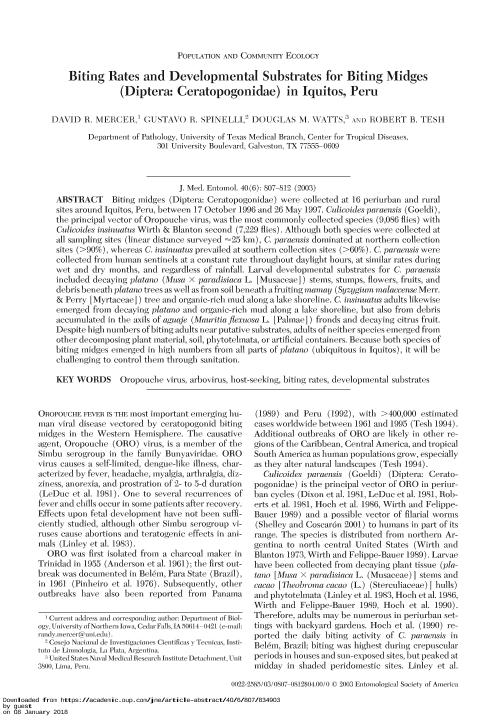Mostrar el registro sencillo del ítem
dc.contributor.author
Mercer, David R.
dc.contributor.author
Spinelli, Gustavo Ricardo

dc.contributor.author
Watts, Douglas M.
dc.contributor.author
Tesh, Robert B.
dc.date.available
2018-01-08T20:48:34Z
dc.date.issued
2003-12
dc.identifier.citation
Tesh, Robert B.; Watts, Douglas M.; Spinelli, Gustavo Ricardo; Mercer, David R.; Biting rates and developmental substrates for biting midges (Diptera: Ceratopogonidae) in Iquitos, Peru; Oxford University Press; Journal of Medical Entomology; 40; 6; 12-2003; 807-812
dc.identifier.issn
0022-2585
dc.identifier.uri
http://hdl.handle.net/11336/32584
dc.description.abstract
Biting midges (Diptera: Ceratopogonidae) were collected at 16 periurban and rural sites around Iquitos, Peru, between 17 October 1996 and 26 May 1997. Culicoides paraensis (Goeldi), the principal vector of Oropouche virus, was the most commonly collected species (9,086 flies) with Culicoides insinuatus Wirth & Blanton second (7,229 flies). Although both species were collected at all sampling sites (linear distance surveyed 25 km), C. paraensis dominated at northern collection sites (>90%), whereas C. insinuatus prevailed at southern collection sites (>60%). C. paraensis were collected from human sentinels at a constant rate throughtout daylight hours, at similar rates during wet and dry months, and regardless of rainfall. Larval developmental substrates for C. paraensis included platano (Musa paradisiaca L. [Musaceae]) stems, stumps, flowers, fruits, and debris beneath platano trees as well as from soil beneath a fruiting mamay (Syzygium malaccense Merr & Perry [Myrtaceae]) tree and organic-rich mud along a lake shoreline, C. insinuatus adults likewise emerged from decaying platano and organic-rich mud along a lake shoreline, but also from debris accumulated in the axils of aguaje (Mauritia flexuosa L. [Palmae]) fronds and decaying citrus fruit. Despite high numbers of biting adults near putative substrates, adults of neither species emerged from other decomposing plant material, soil, phytotelmata, or artificial containers. Because both species of biting midges emerged in high numbers from all parts of platano (ubiquitous in Iquitos), it will be chellenging to control them through sanitation.
dc.format
application/pdf
dc.language.iso
eng
dc.publisher
Oxford University Press

dc.rights
info:eu-repo/semantics/openAccess
dc.rights.uri
https://creativecommons.org/licenses/by-nc-sa/2.5/ar/
dc.subject
Biting Midges
dc.subject
Breeding Substrates
dc.subject
Abundance
dc.subject
Peruvian Amazonia
dc.subject.classification
Biología Marina, Limnología

dc.subject.classification
Ciencias Biológicas

dc.subject.classification
CIENCIAS NATURALES Y EXACTAS

dc.title
Biting rates and developmental substrates for biting midges (Diptera: Ceratopogonidae) in Iquitos, Peru
dc.type
info:eu-repo/semantics/article
dc.type
info:ar-repo/semantics/artículo
dc.type
info:eu-repo/semantics/publishedVersion
dc.date.updated
2017-12-12T20:02:31Z
dc.journal.volume
40
dc.journal.number
6
dc.journal.pagination
807-812
dc.journal.pais
Reino Unido

dc.journal.ciudad
Oxford
dc.description.fil
Fil: Mercer, David R.. University of Northern Iowa; Estados Unidos. University of Texas; Estados Unidos
dc.description.fil
Fil: Spinelli, Gustavo Ricardo. University of Texas; Estados Unidos. Consejo Nacional de Investigaciones Científicas y Técnicas. Centro Científico Tecnológico Conicet - La Plata. Instituto de Limnología ; Argentina
dc.description.fil
Fil: Watts, Douglas M.. University of Texas; Estados Unidos. United States Naval Medical Research Institute Detachment; Perú
dc.description.fil
Fil: Tesh, Robert B.. University of Texas; Estados Unidos. United States Naval Medical Research Institute Detachment; Perú
dc.journal.title
Journal of Medical Entomology

dc.relation.alternativeid
info:eu-repo/semantics/altIdentifier/url/https://academic.oup.com/jme/article/40/6/807/834903
dc.relation.alternativeid
info:eu-repo/semantics/altIdentifier/doi/http://dx.doi.org/10.1603/0022-2585-40.6.807
Archivos asociados
